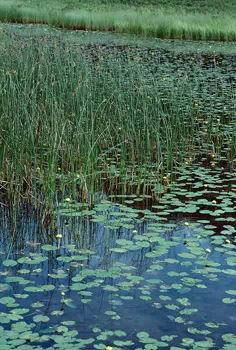Overview
Relevant Activities
Role of Local Governments
U.S. EPA Resources
Other Resources
States
Other Federal Agencies & Programs
Associations for Local Officials
Funding & Financing
A wetland is an area of land that is covered all or part of the year with fresh or salt water. The term is the collective term for marshes, swamps, bogs, and similar areas. Wetlands provide many ecosystem services such as natural water filtration to improve water quality; habitat for many species, including some that are threatened or endangered; and retention of water to reduce flooding. Wetlands also improve the quality of drinking water resources, reduce damage from flooding and erosion, and provide for popular outdoor recreational activities.
Due to their unique vegetation and topography, wetlands tend to act as giant sponges, absorbing, storing, and slowly releasing water from runoff and other sources. As a result, wetlands can lessen the severity of floods and accompanying property damage from erosion. They improve drinking water quality by intercepting surface water runoff, removing nutrients, processing organic wastes, and reducing sediment before it reaches open water. Water leaves wetlands substantially cleaner than it entered. In addition, wetlands provide opportunities for popular activities such as hiking, fishing, hunting, and boating.
The EPA's role in wetland protection is funding state and federal agency involvement in wetland research and protection, especially in biological assessment and monitoring techniques. The EPA also develops rules to regulate municipal and industrial wastewater discharge and stormwater discharge, and it oversees the U.S. Army Corps of Engineers regulating activities under Section 404 of the Clean Water Act. Under Section 404, the Corps has permitting authority over the discharge of dredged and fill materials into "waters of the United States," including wetlands. EPA develops and interprets environmental criteria used in evaluating permit applications and has veto power over a permit granted by the Corps. Most of EPA's responsibilities are carried out by regional offices as opposed to the national headquarters.
The U.S. Supreme Court in Sackett v. EPA (2023) revisited federal jurisdiction under Section 404, holding that "waters of the United States" refers only to "geographic[al] features that are described in ordinary parlance as 'streams, oceans, rivers, and lakes'" and to adjacent wetlands that are "indistinguishable" from those bodies of water due to a continuous surface connection. This interpretation of the term has had ripple effects as well, as state laws that relied on the federal definition also took on that same meaning.
- Bridges, Roads, and Other Infrastructure Construction & Maintenance
- Building Maintenance, Renovation, and Construction
- Public Land Management
States play a critical role in the protection and management of our nation's wetlands. Most states have increased their roles in wetlands protection and management by adopting any of a number of wetlands programs or tools. Components of comprehensive wetlands programs adopted by states include:
- Assuming the federal Clean Water Act Section 404 permit program or obtaining State Program General Permits from the Corps of Engineers.
- Undertaking comprehensive State Wetland Conservation Plans, which identify strengths and needs in a state's program and often develop the framework for a state's wetlands program.
- Developing narrative wetland water quality standards.
- Applying the Clean Water Act Section 401 Water Quality Certification program.
- Adopting non-regulatory programs such as watershed/wetlands planning initiatives, taxation programs, acquisition programs, and others.
- Incorporating wetlands considerations into other state water programs.
Local governments can assist in the protection of wetlands by educating landowners about federal and state protection and restoration programs, mapping wetlands, identifying restoration priorities, acquiring important wetlands, and monitoring.
U.S. Environmental Protection Agency Resources
- EPA Wetlands Program. Describes the EPA's role in wetland protection.
- Guiding Principles for Constructed Treatment Wetlands: Providing for Water Quality and Wildlife Habitat. Provides local officials with guidelines for many issues surrounding constructed treatment wetlands.
- Protecting Natural Wetlands: A Guide to Stormwater Best Management Practices. This manual is intended for use by anyone addressing potential impacts to wetlands from stormwater runoff, and it presents a wide range of planning approaches as well as specific best management practices that can be employed in a variety of situations.
- Wetlands Fact Sheets. This series of wetlands fact sheets covers a wide variety of topics, such as economic benefits, wetlands mitigation banking, the local role in wetlands protection, Section 404 of the Clean Water Act, and more.
-
Wetlands Education Links. Links to numerous non-EPA wetlands resources for students, via the EPA website.
-
State Wetlands Resource Locator. This locator can be used to find individual state laws and regulations on wetlands protection, many of which define the state's role in the §404 permit/§401 certification process.
Other Federal Agencies & Programs
-
U.S. Army Corps of Engineers. The mission of the Corps of Engineers Regulatory Program is to protect the Nation's aquatic resources, while allowing reasonable development through fair, flexible and balanced permit decisions. The Corps evaluates permit applications for essentially all construction activities that occur in the Nation's waters, including wetlands.
Associations for Local Officials
- National Association of Wetland Managers. The National Association of Wetland Managers website provides information on wetlands news and events, including new regulations/legislation, upcoming conferences and events, publications, and more.
- Society of Wetland Scientists. The Society of Wetland Scientists Web site provides access to on-line scientific wetlands journals and a wetlands discussion forum, as well as information on upcoming wetlands conferences and events.
State/Tribal/Local Wetlands Grant Program: Since 1990, this federal grant program has supported State, Tribal, and local efforts to protect wetlands by providing funds to enhance existing programs or develop new programs.
Five Star Restoration Training Grants. Awards grants to various entities to provide environmental education and training through projects that restore wetlands and streams throughout the United States.
- Wetland Program Development Grants Guidelines. Specifics on eligibility, requirements, and priorities for the Wetlands Program Development Grants.
- Wetland Program Development Grant Case Studies. This document highlights successful use of WPDGs in building one or more elements of a wetlands protection program and serves as an example to others who are striving to develop comprehensive programs.
For more information on funding and financing programs and options for wetlands, please see the Wetlands section of LGEAN's Funding & Financing page.


